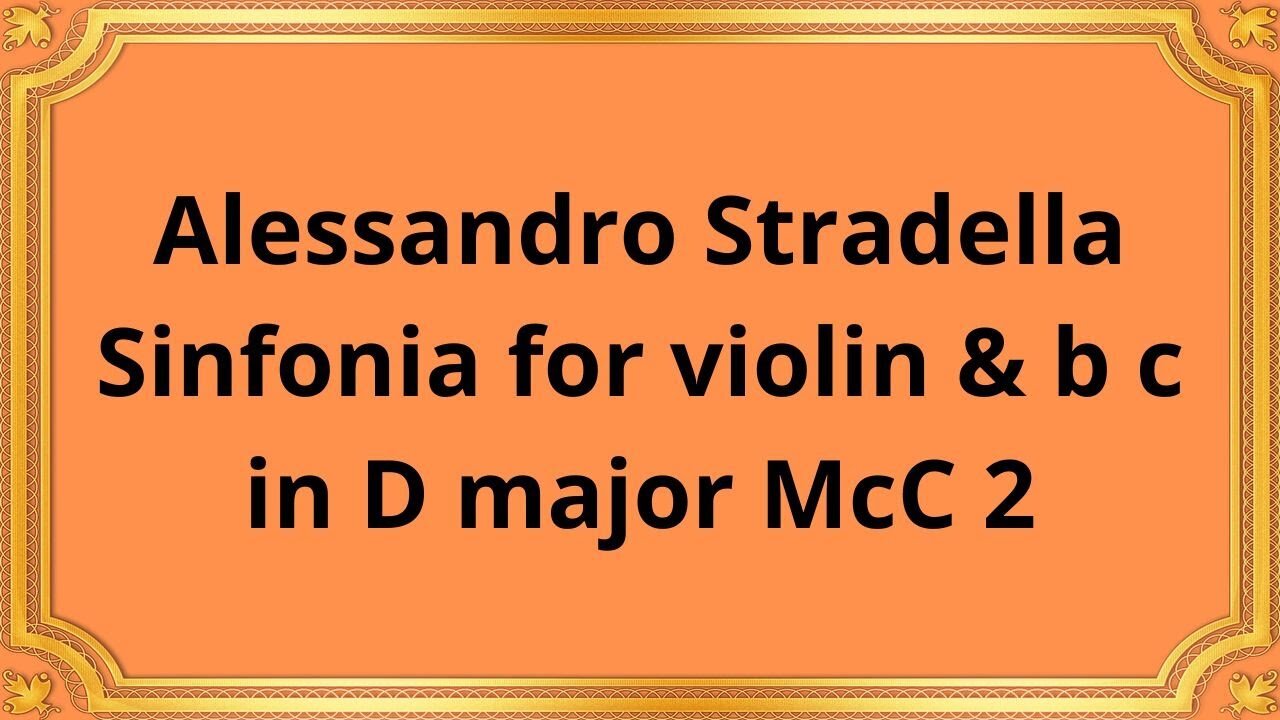Premium Only Content

Alessandro Stradella Sinfonia for violin & b c in D major McC 2
#AlessandroStradella #Sinfonia #Violin #BassoContinuo #DMajor #McC2 #ClassicalMusic #MusicalComposition #BaroqueEra #ItalianComposer #InstrumentalMusic
Publication date 1954
Trio di Bolzano
Nunzio Montanari (piano)
Giannino Carpi (violin)
Antonio Valisi (’cello)
Alessandro Stradella, an esteemed Italian composer of the Baroque era, has left an indelible mark on the world of classical music. His Sinfonia for Violin & Basso Continuo in D Major (McC 2) stands as a testament to his exceptional compositional skill and musical ingenuity.
Composed during the Baroque era, a period renowned for its artistic and musical innovations, Stradella's Sinfonia embodies the stylistic characteristics of the time. As an Italian composer, Stradella played a significant role in shaping the musical landscape, and this composition showcases his mastery in blending melody, harmony, and virtuosity.
The Sinfonia for Violin & Basso Continuo in D Major comprises several movements that highlight Stradella's ability to craft engaging and expressive instrumental music.
1. Introduction:
The sinfonia opens with a captivating introduction, establishing the key and setting the mood for the entire piece. Stradella's use of harmonic richness and rhythmic drive immediately captures the listener's attention, immersing them in the world of the composition.
2. Allegro:
The first movement, marked Allegro, unfolds with a lively and energetic character. The violin takes the lead, engaging in a spirited dialogue with the basso continuo. Stradella's use of intricate melodic patterns and vibrant harmonies creates a sense of musical conversation and dynamic interplay.
3. Adagio:
Following the exuberant Allegro, the Adagio movement provides a contrasting and introspective moment within the sinfonia. The violin takes center stage, delivering poignant and lyrical melodies supported by the basso continuo. Stradella's use of expressive harmonies and ornamentation adds depth and emotional richness to this movement, invoking a sense of serenity and introspection.
4. Allegro finale:
The final movement, marked Allegro, brings the sinfonia to a thrilling conclusion. Stradella employs virtuosic passages and lively rhythms to showcase the technical abilities of the violin. The movement combines elements of dance-like motifs with intricate melodic variations, creating a sense of excitement and anticipation.
Impact and Influence:
Stradella's Sinfonia for Violin & Basso Continuo in D Major (McC 2) has had a lasting impact on the world of instrumental music. Its technical brilliance, emotive melodies, and seamless interplay between the violin and basso continuo have influenced subsequent composers and performers. Stradella's ability to blend virtuosity with expressive depth has made this sinfonia a cherished addition to the repertoire of Baroque chamber music.
Conclusion:
Alessandro Stradella's Sinfonia for Violin & Basso Continuo in D Major (McC 2) stands as a testament to the composer's mastery of Baroque instrumental music. Through its vibrant and dynamic musical structure, the composition showcases Stradella's ability to create engaging dialogues between the violin and basso continuo, evoking a range of emotions within the listener. As we continue to appreciate and study this remarkable work, we gain a deeper understanding of Stradella's significant contribution to the rich tapestry of classical music.
You have the opportunity to support the channel:
https://destream.net/live/RadSiarAl/donate
https://www.buymeacoffee.com/6355radsiaral
-
 41:38
41:38
Classical music_Music Inspiration
1 month agoNikolai Andreevich Rimsky Korsakov Symphonic Suite “Scheherazade”
1701 -
 24:24
24:24
Jasmin Laine
7 hours ago“Their BIGGEST Mistake Yet”—U.S. Officials TORCH Carney in Brutal Report
29K26 -
 LIVE
LIVE
Rallied
4 hours ago $0.12 earnedWARZONE SOLO CHALLENGES ALL DAY
459 watching -
 2:00:33
2:00:33
Joker Effect
3 hours agoSoo @MrBeast charity, is it legit? XenaTheWitch got attested? Lets talk about it! HOW TO GO VIRAL.
18.8K1 -
 27:01
27:01
TheRoyaltyAutoService
10 hours ago $0.06 earnedAnother Shop Replaced The Timing Belt & Fuel Injectors On This Honda Pilot… Now It Has No Power!
31.9K3 -
 10:14:25
10:14:25
GritsGG
12 hours agoRanked Crim 2! Most Wins 3390+ 🧠
62.7K -
 3:12:37
3:12:37
IsaiahLCarter
1 day ago $1.69 earnedJonah O. Wheeler: In Defense of Reality || APOSTATE RADIO #026
31.4K1 -
 LIVE
LIVE
Cewpins
6 hours agoSmoke Sesh🔥Gaming???💨420🍃!MJ !giveaway
161 watching -
 LIVE
LIVE
Phyxicx
5 hours agoShin Megami Tensei - Part 5 - 8/13/2025 | Chaos Route | Expert Difficulty
99 watching -
 1:59:32
1:59:32
vivafrei
15 hours agoEp. 277: Russia Peace Talks! Trump D.C. Takeover Leads to Lawsuit! Heat Wave Lawsuit? AND MORE!
84.5K116